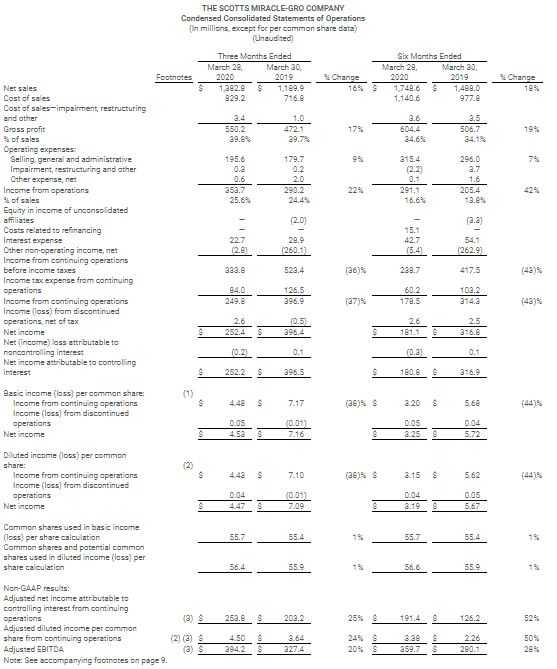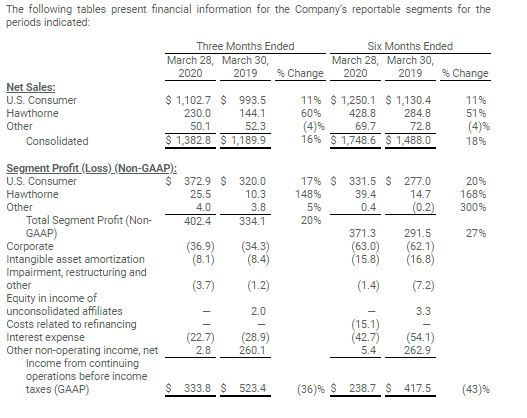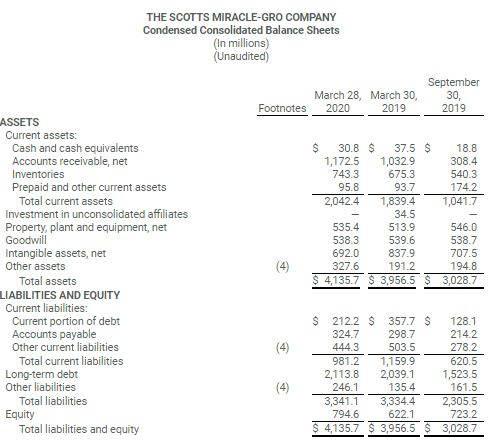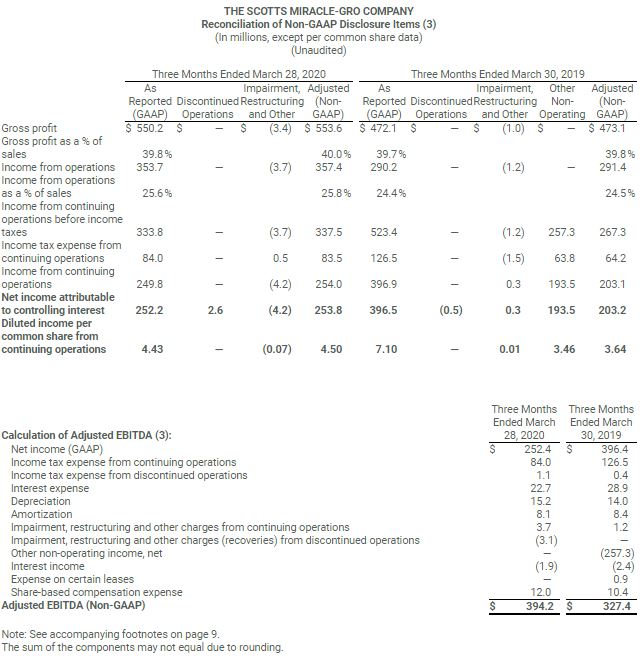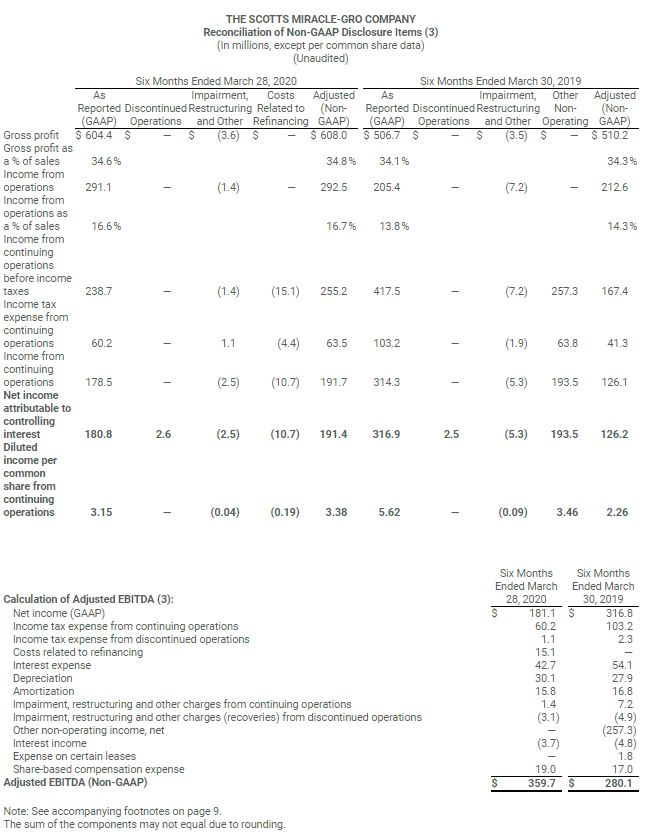
ScottsMiracle-Gro Announces Second Quarter Results Driven by Strong Growth in Both Major Reporting Segments
Sales guidance increased for Hawthorne; 2020 adjusted EPS guidance re-affirmed
- Hawthorne sales rise 60% driven by continued demand for indoor growing products
- U.S. Consumer sales increase 11% with strong growth in consumer purchases
- GAAP EPS: $4.43 versus $7.10; Non-GAAP adjusted EPS of $4.50 versus $3.64
MARYSVILLE, Ohio, May 06, 2020 (GLOBE NEWSWIRE) — The Scotts Miracle-Gro Company (NYSE: SMG), the world’s leading marketer of branded consumer lawn and garden as well as indoor and hydroponic growing products, today announced company-wide sales increased 16 percent in its fiscal second quarter driven by strong volume growth in both major business segments.
For the quarter ended March 28, 2020, GAAP earnings from continuing operations were $4.43 per share compared with $7.10 per share in the prior year. Prior year GAAP results were driven by the divestiture of the Company’s minority interest in TruGreen. Non-GAAP adjusted earnings – which are the basis of the Company’s financial guidance – were $4.50 per share compared with $3.64 a year ago.
On a year-to-date basis through May 3, 2020, consumer purchases of the Company’s core lawn and garden products at its largest four retailers in the U.S. increased 8 percent from the same period a year ago driven primarily by strong growth in gardening and insect control products. Entering April, year-to-date POS at those retailers was up 14 percent driven by an increase of more than 20 percent during the second quarter.
“Consumers and retailers have remained engaged in the lawn and garden category and supportive of our brands despite the challenges of the COVID-19 crisis,” said Jim Hagedorn, chairman and chief executive officer. “During April, in the face of difficult year-over-year comparisons and shelter-in-place orders in much of the United States, consumer purchases remained strong. In fact, for the week ending May 3, we recorded our strongest seven-day period in company history with consumer purchases of more than $190 million at our largest four retail partners. All of this allows us to remain confident in our full-year growth outlook for the U.S. Consumer segment.”
At Hawthorne, we continue to see gains in all product categories and we continue to significantly outperform the competition.
 Jim Hagedorn, chairman and chief executive officer
Jim Hagedorn, chairman and chief executive officer
Even in the face of extremely difficult comparisons over the past two months, we are continuing to see strong year-over-year increases, giving us confidence that sales for the segment will increase approximately 30 to 35 percent for the full year, compared to our original sales guidance of 12 to 15 percent growth.
Second quarter details
For the fiscal second quarter, the Company reported sales of $1.38 billion, up 16 percent from $1.19 billion a year earlier. U.S. Consumer segment sales increased 11 percent to $1.10 billion. Sales for the Hawthorne segment increased 60 percent to $230.0 million.
The company-wide gross margin rate was 39.8 percent on a GAAP basis and 40.0 percent on a non-GAAP adjusted basis compared with a rate of 39.7 percent and 39.8 percent respectively a year ago. The quarter benefited from the timing of $20 million of higher Roundup commission, related to the Company’s role as marketing agent and consistent with changes in the revised agency agreement signed with Bayer in 2019. Separately, in the third quarter of 2019, the Company received a $20 million reimbursement from Bayer. Therefore, the full year Roundup income and its impact on the gross margin rate are expected to be consistent across both years.
The impact of the commission increase, as well as benefits from pricing and volume, were offset by negative product mix driven primarily by the strong growth of Hawthorne, which has lower overall margins. Selling, general and administrative expenses (SG&A) increased 9 percent to $195.6 million due to higher selling and marketing expenses and higher accruals related to variable compensation.
Other non-operating income was $2.8 million compared with $260.1 million a year earlier that was due primarily to a pre-tax gain of $259.8 million related to the Company’s divestiture of its minority ownership of TruGreen.
On a company-wide basis, GAAP income from continuing operations was $249.8 million, or $4.43 per diluted share, compared with $396.9 million, or $7.10 per share, for the second quarter of fiscal 2019. These results include impairment, restructuring, and other items. Excluding these items, non-GAAP adjusted earnings was $253.8 million, or $4.50 per diluted share, compared with $203.2 million, or $3.64 per share, last year. The higher Roundup commission contributed approximately $0.25 per share during the quarter.
“During the quarter, we also recognized approximately $4 million in expenses related to COVID-19 that we have excluded from our adjusted earnings calculation,” said Randy Coleman, chief financial officer. “These costs include premium pay adjustments that were given to our front-line associates who work in the sales force, as well as our manufacturing and distribution facilities. While the management team has been working remotely throughout the crisis, these associates – roughly 70 percent of our workforce – continued to work in stores and facilities across the globe. We believe the pay adjustments they are receiving appropriately recognize the sacrifice they are making during this critical period. On a full-year basis, we expect to record $30 to $35 million of one-time costs that we will exclude from adjusted earnings as they are not expected to repeat in future years.”
Year-to-date details
For the first six months of fiscal 2020, the Company reported sales of $1.75 billion, up 18 percent from $1.49 billion a year earlier. U.S. Consumer segment sales increased 11 percent to $1.25 billion. Sales for the Hawthorne segment increased 51 percent to $428.8 million.
The company-wide gross margin rate was 34.6 percent on a GAAP basis and 34.8 percent on a non-GAAP adjusted basis compared with a rate of 34.1 percent and 34.3 percent respectively a year ago. Selling, general and administrative expense (SG&A) increased 7 percent to $315.4 million.
Other non-operating income was $5.4 million compared with $262.9 million a year earlier.
On a company-wide basis, GAAP income from continuing operations was $178.5 million, or $3.15 per share, compared with $314.3 million, or $5.62 per share, for the first six months of fiscal 2019. Excluding impairment, restructuring, and other items, non-GAAP adjusted earnings was $191.4 million, or $3.38 per share, compared with $126.2 million, or $2.26 per share, last year.
Full-year outlook
The Company now expects for Hawthorne sales to increase 30 to 35 percent for fiscal 2020 and it re-affirmed a sales outlook for the U.S. Consumer segment of 1 to 3 percent growth. As a result, the Company now expects company-wide sales growth in a range of 6 to 8 percent for the full year. All other aspects of its fiscal 2020 guidance were re-affirmed although management acknowledged the strong start in both the U.S. Consumer and Hawthorne segments increases the possibility that full-year adjusted earnings could exceed its original forecast.
“We have a high degree of confidence in our guidance for non-GAAP adjusted earnings in a range of $4.95 to $5.15 per share,” Coleman said. “While year-over-year comparisons for our U.S. Consumer segment are relatively modest for the balance of the year, more than half of consumer purchases occur between now and our fiscal year-end. There are simply too many unknown factors regarding consumer and retailer engagement right now to justify changing our bottom-line outlook. We currently anticipate providing the financial community with an updated outlook on fiscal 2020 in early June, consistent with how we’ve operated in the past.”
Conference Call and Webcast Scheduled for 9 a.m. EDT Today, May 6
The Company will discuss results during a webcast and conference call today at 9:00 a.m. EDT. To participate in the conference call, please call 1-800-263-0877 (Conference Code: 7872492). A replay of the call can be heard by calling 1-888-203-1112. The replay will be available for 30 days. A live webcast of the call and the press release will be available on the Company’s investor relations website at http://investor.scotts.com. An archive of the press release and any accompanying information will remain available for at least a 12-month period.
About ScottsMiracle-Gro
With approximately $3.2 billion in sales, the Company is one of the world’s largest marketers of branded consumer products for lawn and garden care. The Company’s brands are among the most recognized in the industry. The Company’s Scotts®, Miracle-Gro® and Ortho® brands are market-leading in their categories. The Company’s wholly-owned subsidiary, The Hawthorne Gardening Company, is a leading provider of nutrients, lighting and other materials used in the indoor and hydroponic growing segment. For additional information, visit us at www.scottsmiraclegro.com.
THE SCOTTS MIRACLE-GRO COMPANY
Segment Results
(In millions)
(Unaudited)
The Company divides its business into three reportable segments: U.S. Consumer, Hawthorne and Other. U.S. Consumer consists of the Company’s consumer lawn and garden business located in the geographic United States. Hawthorne consists of the Company’s indoor, urban and hydroponic gardening business. Other consists of the Company’s consumer lawn and garden business in geographies other than the U.S. and the Company’s product sales to commercial nurseries, greenhouses and other professional customers. In addition, Corporate consists of general and administrative expenses and certain other income/expense items not allocated to the business segments. This identification of reportable segments is consistent with how the segments report to and are managed by the chief operating decision maker of the Company.
The performance of each reportable segment is evaluated based on several factors, including income (loss) from continuing operations before income taxes, amortization, impairment, restructuring and other charges (“Segment Profit (Loss)”), which is a non-GAAP financial measure. Senior management uses Segment Profit (Loss) to evaluate segment performance because they believe this measure is indicative of performance trends and the overall earnings potential of each segment.
THE SCOTTS MIRACLE-GRO COMPANY
Footnotes to Preceding Financial Statements
(1) Basic income (loss) per common share amounts are calculated by dividing income (loss) attributable to controlling interest from continuing operations, income (loss) from discontinued operations and net income (loss) attributable to controlling interest by the weighted average number of common shares outstanding during the period.
(2) Diluted income (loss) per common share amounts are calculated by dividing income (loss) attributable to controlling interest from continuing operations, income (loss) from discontinued operations and net income (loss) attributable to controlling interest by the weighted average number of common shares, plus all potential dilutive securities (common stock options, performance shares, performance units, restricted stock and restricted stock units) outstanding during the period.
(3) Reconciliation of Non-GAAP Measures
Use of Non-GAAP Measures
To supplement the financial measures prepared in accordance with U.S. generally accepted accounting principles (“GAAP”), the Company uses non-GAAP financial measures. The reconciliations of these non-GAAP financial measures to the most directly comparable financial measures calculated and presented in accordance with GAAP are shown in the tables above. These non-GAAP financial measures should not be considered in isolation from, or as a substitute for or superior to, financial measures reported in accordance with GAAP. Moreover, these non-GAAP financial measures have limitations in that they do not reflect all the items associated with the operations of the business as determined in accordance with GAAP. Other companies may calculate similarly titled non-GAAP financial measures differently than the Company, limiting the usefulness of those measures for comparative purposes.
In addition to GAAP measures, management uses these non-GAAP financial measures to evaluate the Company’s performance, engage in financial and operational planning and determine incentive compensation because it believes that these measures provide additional perspective on and, in some circumstances are more closely correlated to, the performance of the Company’s underlying, ongoing business.
Management believes that these non-GAAP financial measures are useful to investors in their assessment of operating performance and the valuation of the Company. In addition, these non-GAAP financial measures address questions routinely received from analysts and investors and, in order to ensure that all investors have access to the same data, management has determined that it is appropriate to make this data available to all investors. Non-GAAP financial measures exclude the impact of certain items (as further described below) and provide supplemental information regarding operating performance. By disclosing these non-GAAP financial measures, management intends to provide investors with a supplemental comparison of operating results and trends for the periods presented. Management believes these measures are also useful to investors as such measures allow investors to evaluate performance using the same metrics that management uses to evaluate past performance and prospects for future performance. Management views free cash flow as an important measure because it is one factor used in determining the amount of cash available for dividends and discretionary investment. Management views free cash flow productivity as a useful measure to help investors understand the Company’s ability to generate cash.
Exclusions from Non-GAAP Financial Measures
Non-GAAP financial measures reflect adjustments based on the following items:
- Impairments, which are excluded because they do not occur in or reflect the ordinary course of the Company’s ongoing business operations and their exclusion results in a metric that provides supplemental information about the sustainability of operating performance.
- Restructuring and employee severance costs, which include charges for discrete projects or transactions that fundamentally change the Company’s operations and are excluded because they are not part of the ongoing operations of its underlying business, which includes normal levels of reinvestment in the business.
- Costs related to refinancing, which are excluded because they do not typically occur in the normal course of business and may obscure analysis of trends and financial performance. Additionally, the amount and frequency of these types of charges is not consistent and is significantly impacted by the timing and size of debt financing transactions.
- Discontinued operations and other unusual items, which include costs or gains related to discrete projects or transactions and are excluded because they are not comparable from one period to the next and are not part of the ongoing operations of the Company’s underlying business.
The tax effect for each of the items listed above is determined using the tax rate and other tax attributes applicable to the item and the jurisdiction(s) in which the item is recorded.Definitions of Non-GAAP Financial MeasuresThe reconciliations of non-GAAP disclosure items include the following financial measures that are not calculated in accordance with GAAP and are utilized by management in evaluating the performance of the business, engaging in financial and operational planning, the determination of incentive compensation, and by investors and analysts in evaluating performance of the business:
Adjusted gross profit: Gross profit excluding impairment, restructuring and other charges / recoveries.
Adjusted income (loss) from operations: Income (loss) from operations excluding impairment, restructuring and other charges / recoveries.
Adjusted income (loss) from continuing operations before income taxes: Income (loss) from continuing operations before income taxes excluding impairment, restructuring and other charges / recoveries and costs related to refinancing.
Adjusted income tax expense (benefit) from continuing operations: Income tax expense (benefit) from continuing operations excluding the tax effect of impairment, restructuring and other charges / recoveries and costs related to refinancing.
Adjusted income (loss) from continuing operations: Income (loss) from continuing operations excluding impairment, restructuring and other charges / recoveries and costs related to refinancing, each net of tax.
Adjusted net income (loss) attributable to controlling interest from continuing operations: Net income (loss) attributable to controlling interest excluding impairment, restructuring and other charges / recoveries, costs related to refinancing and discontinued operations, each net of tax.
Adjusted diluted income (loss) per common share from continuing operations: Diluted net income (loss) per common share from continuing operations excluding impairment, restructuring and other charges / recoveries and costs related to refinancing, each net of tax.
Adjusted EBITDA: Net income (loss) before interest, taxes, depreciation and amortization as well as certain other items such as the impact of the cumulative effect of changes in accounting, costs associated with debt refinancing and other non-recurring or non-cash items affecting net income (loss). The presentation of adjusted EBITDA is intended to be consistent with the calculation of that measure as required by the Company’s borrowing arrangements, and used to calculate a leverage ratio (maximum of 4.75 at March 28, 2020) and an interest coverage ratio (minimum of 3.00 for the twelve months ended March 28, 2020).
Free cash flow: Net cash provided by (used in) operating activities reduced by investments in property, plant and equipment.
Free cash flow productivity: Ratio of free cash flow to net income (loss).
For the three and six months ended March 28, 2020, the following items were adjusted, in accordance with the definitions above, to arrive at the non-GAAP financial measures:
- The World Health Organization recognized a novel strain of coronavirus (“COVID-19”) as a public health emergency of international concern on January 30, 2020 and as a global pandemic on March 11, 2020. In response to the COVID-19 pandemic, the Company has implemented additional measures intended to both protect the health and safety of its employees and maintain its ability to provide products to its customers, including (i) requiring a significant part of its workforce to work from home, (ii) monitoring its employees for COVID-19 symptoms, (iii) making additional personal protective equipment available to its operations team, (iv) requiring all manufacturing and warehousing associates to take their temperatures before beginning a shift, (v) modifying work methods and schedules of its manufacturing and field associates to create distance or add barriers between associates, consumers and others, (vi) expanding cleaning efforts at its operation centers, (vii) modifying attendance policies so that associates may elect to stay home if they have symptoms, (viii) prioritizing production for goods that are more essential to its customers and (ix) implementing an interim premium pay allowance for associates in its field sales force as well as those still working in manufacturing or distribution centers. In addition, to help address the critical shortage of personal protective equipment in the fight against COVID-19, the Company has shifted production in its Temecula, California manufacturing plant to produce face shields to help protect healthcare workers and first responders in critical need areas across the country. During the three and six months ended March 28, 2020, the Company incurred costs of $3.1 million in the “Cost of sales—impairment, restructuring and other” line in the Condensed Consolidated Statements of Operations and incurred costs of $0.7 million in the “Impairment, restructuring and other” line in the Condensed Consolidated Statements of Operations associated with the COVID-19 pandemic primarily related to premium pay and incremental cleaning costs. These direct and incremental costs were excluded from the Company’s non-GAAP financial measures because they are not comparable from one period to the next and are not expected to be part of the ongoing operations of the Company’s underlying business. As a result of these additional measures and initiatives, the Company expects to incur up to $35 million of incremental costs, mostly related to premium pay provided to its associates.
- In connection with the acquisition of Sunlight Supply during the third quarter of fiscal 2018, the Company announced the launch of an initiative called Project Catalyst, which is a company-wide restructuring effort to reduce operating costs throughout the U.S. Consumer, Hawthorne and Other segments and drive synergies from recent acquisitions within the Hawthorne segment. Costs incurred during the three and six months ended March 28, 2020 related to Project Catalyst were not material. Additionally, during the three and six months ended March 28, 2020, the Company received zero and $2.6 million, respectively, from the final settlement of escrow funds related to a previous Hawthorne acquisition that was recognized in the “Impairment, restructuring and other” line in the Condensed Consolidated Statements of Operations.
- On October 23, 2019, the Company redeemed all of its outstanding 6.000% Senior Notes for a redemption price of $412.5 million, comprised of $0.5 million of accrued and unpaid interest, $12.0 million of redemption premium, and $400.0 million for outstanding principal amount. The $12.0 million redemption premium was recognized in the “Costs related to refinancing” line on the Condensed Consolidated Statements of Operations during the first quarter of fiscal 2020. Additionally, the Company had $3.1 million in unamortized bond issuance costs associated with the 6.000% Senior Notes, which were written-off during the first quarter of fiscal 2020 and were recognized in the “Costs related to refinancing” line in the Condensed Consolidated Statements of Operations.
- The Company recognized insurance recoveries of $1.5 million related to the previously disclosed legal matter In re Morning Song Bird Food Litigation during the three and six months ended March 28, 2020 in the “Income (loss) from discontinued operations, net of tax” line in the Condensed Consolidated Statements of Operations.
For the three and six months ended March 30, 2019, the following items were adjusted, in accordance with the definitions above, to arrive at the non-GAAP financial measures:
- On March 19, 2019, the Company entered into an agreement under which it sold, to TruGreen Companies L.L.C., a subsidiary of TruGreen Holding Corporation, all of its approximately 30% equity interest in Outdoor Home Services Holdings LLC, a lawn services joint venture between the Company and TruGreen Holding Corporation (the “TruGreen Joint Venture”). Under the terms of the agreement, the Company received cash proceeds of $234.2 million related to the sale of its equity interest in the TruGreen Joint Venture and $18.4 million related to the payoff of second lien term loan financing. During the three and six months ended March 30, 2019, the Company recognized a pre-tax gain of $259.8 million related to this sale in the “Other non-operating income, net” line in the Condensed Consolidated Statement of Operations.
- During the three and six months ended March 30, 2019, the Company recognized charges of $2.1 million and $7.6 million, respectively, related to Project Catalyst. During the three and six months ended March 30, 2019, the Company recognized charges of $1.0 million and $3.5 million, respectively, in the “Cost of sales—impairment, restructuring and other” line in the Condensed Consolidated Statements of Operations related to employee termination benefits, facility closure costs and impairment of property, plant and equipment. During the three and six months ended March 30, 2019, the Company recognized charges of $1.1 million and $4.1 million, respectively, in the “Impairment, restructuring and other” line in the Condensed Consolidated Statements of Operations related to employee termination benefits and facility closure costs. The Company also recognized a charge of $2.5 million for the three and six months ended March 30, 2019 in the “Other non-operating income, net” line in the Condensed Consolidated Statements of Operations related to the write-off of accumulated foreign currency translation loss adjustments of a foreign subsidiary that was substantially liquidated.
- The Company recognized favorable adjustments of $0.9 million and $0.4 million related to the previously disclosed legal matter In re Scotts EZ Seed Litigation during the three and six months ended March 30, 2019, respectively, in the “Impairment, restructuring and other” line in the Condensed Consolidated Statements of Operations.
- The Company recognized insurance recoveries of zero and $5.0 million related to the previously disclosed legal matter In re Morning Song Bird Food Litigation during the three and six months ended March 30, 2019, respectively, in the “Income (loss) from discontinued operations, net of tax” line in the Condensed Consolidated Statements of Operations.

